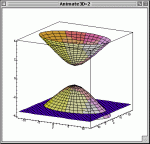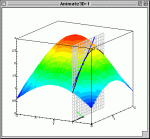You are using an out of date browser. It may not display this or other websites correctly.
You should upgrade or use an alternative browser.
You should upgrade or use an alternative browser.
find, classify critical points of f(x,y) = 4xy^2-4x^2-2y^2
- Thread starter bamptom
- Start date
mmm4444bot
Super Moderator
- Joined
- Oct 6, 2005
- Messages
- 10,958
Please show your work ...
Hi there.
Your f[sub:3mc85jib]y[/sub:3mc85jib](x) looks good to me.
Please show me your work on f[sub:3mc85jib]x[/sub:3mc85jib](x).
Once you're sure that you've got the correct definitions for both partial derivatives, then the next step is to use them to determine the x- and y-coordinates of the critical point(s).
I don't know whether or not you understand why this is the next step.
Do you know what the term "critical point" means?
Do you understand the terms, "minimum", "maximum", and "saddle" with respect to a 3-d surface?
Do you understand the relationship between all four of these terms and the partial derivatives' behavior at the critical points?
I would like more information about why you're stuck because I'm not sure what knowledge you already understand; it's hard for me to know what information you would like.
Please show me your work on f[sub:3mc85jib]x[/sub:3mc85jib](x) and explain why you're stuck.
Cheers,
~ Mark
Hi there.
Your f[sub:3mc85jib]y[/sub:3mc85jib](x) looks good to me.
Please show me your work on f[sub:3mc85jib]x[/sub:3mc85jib](x).
Once you're sure that you've got the correct definitions for both partial derivatives, then the next step is to use them to determine the x- and y-coordinates of the critical point(s).
I don't know whether or not you understand why this is the next step.
Do you know what the term "critical point" means?
Do you understand the terms, "minimum", "maximum", and "saddle" with respect to a 3-d surface?
Do you understand the relationship between all four of these terms and the partial derivatives' behavior at the critical points?
I would like more information about why you're stuck because I'm not sure what knowledge you already understand; it's hard for me to know what information you would like.
Please show me your work on f[sub:3mc85jib]x[/sub:3mc85jib](x) and explain why you're stuck.
Cheers,
~ Mark
Re: critical points
Hi mark,
I appreciate your help!
i started with fx=4y^2-8x ....... Oops i just realised that isnt correct. I have gotten confused from other examples factorizing these! I Should leave it as is i think?
I understand the critical points to be where the derrivative equals zero, where the function is stationary (slope = 0) which would result in minimum, maximum or saddle points locally?
Does this sound right? Im not sure where to go from here.
Hi mark,
I appreciate your help!
i started with fx=4y^2-8x ....... Oops i just realised that isnt correct. I have gotten confused from other examples factorizing these! I Should leave it as is i think?
I understand the critical points to be where the derrivative equals zero, where the function is stationary (slope = 0) which would result in minimum, maximum or saddle points locally?
Does this sound right? Im not sure where to go from here.
mmm4444bot
Super Moderator
- Joined
- Oct 6, 2005
- Messages
- 10,958
Re: critical points
If you have a point on a surface with xy-coordinates (a, b), then that point is a critical point on the surface IF
f[sub:1nb0r5v3]x[/sub:1nb0r5v3](a,b) = 0
AND
f[sub:1nb0r5v3]y[/sub:1nb0r5v3](a,b) = 0
In other words, the tangent lines at (a, b, z) in both the x- and y-dimensions must be flat.
(Critical points also occur if one of these partial derivatives does not exist.)
You found both of them.
4y[sup:1nb0r5v3]2[/sup:1nb0r5v3] - 8x = 0
8xy - 4y = 0
Do you know how to solve this system of equations to find the xy-coordinates of any critical points?
Also, please let us know whether or not the Second Derivatives Test has been explained to you. In other words, do you know about how to use the second partial derivatives to determine if a critical point is local maximum, local minimum, or saddle point?
Cheers,
~ Mark
PS: Here are some nifty animations that illustrate some of the relationships discussed, but these graphs are NOT for the surface in your exercise.
When the base of the rotating grid is parallel to either the x-axis or y-axis (i.e., parallel to the sides of the cube), then the BLACK curve on the grid shows the behavior of the surface with respect to the x-dimension or the y-dimension. The slope of the BLUE tangent line is the value of the partial derivatives. (NOTE: The point about which the grid is spinning is NOT a critical point; I just want you to visualize partial derivatives as the slope of tangent lines (in the x- and y-directions) at a given point on the surface.) In other words, pick a point, and if the slope of the blue tangent line on the grid is -2 when the base of the grid is parallel to the x-axis, then f[sub:1nb0r5v3]x[/sub:1nb0r5v3](x,y) at that point equals -2.
The plane moving up and down between some values of z shows how a plane that is tangent to the surface at a local minimum or maximum must be parallel to the xy-plane (flat). Since the plane is flat, both f[sub:1nb0r5v3]x[/sub:1nb0r5v3](x) and f[sub:1nb0r5v3]y[/sub:1nb0r5v3](x) must be zero at those points because that tangents along both x and y (contained in the plane and running through the critical point) are flat.
My edit: clarification in green
bamptom said:i started with fx=4y^2-8x ....... Oops i just realised that isnt correct ... ? it looks right to me!
... I understand the critical points to be where the derrivative equals zero ... ? if you're thinking in terms of a single derivative, then you're not thinking in three dimensions
... which would result in minimum, maximum or saddle points locally? ... ? Yes, each of these three possibilities occurs only at a critical point on the surface
If you have a point on a surface with xy-coordinates (a, b), then that point is a critical point on the surface IF
f[sub:1nb0r5v3]x[/sub:1nb0r5v3](a,b) = 0
AND
f[sub:1nb0r5v3]y[/sub:1nb0r5v3](a,b) = 0
In other words, the tangent lines at (a, b, z) in both the x- and y-dimensions must be flat.
(Critical points also occur if one of these partial derivatives does not exist.)
You found both of them.
4y[sup:1nb0r5v3]2[/sup:1nb0r5v3] - 8x = 0
8xy - 4y = 0
Do you know how to solve this system of equations to find the xy-coordinates of any critical points?
Also, please let us know whether or not the Second Derivatives Test has been explained to you. In other words, do you know about how to use the second partial derivatives to determine if a critical point is local maximum, local minimum, or saddle point?
Cheers,
~ Mark
PS: Here are some nifty animations that illustrate some of the relationships discussed, but these graphs are NOT for the surface in your exercise.
When the base of the rotating grid is parallel to either the x-axis or y-axis (i.e., parallel to the sides of the cube), then the BLACK curve on the grid shows the behavior of the surface with respect to the x-dimension or the y-dimension. The slope of the BLUE tangent line is the value of the partial derivatives. (NOTE: The point about which the grid is spinning is NOT a critical point; I just want you to visualize partial derivatives as the slope of tangent lines (in the x- and y-directions) at a given point on the surface.) In other words, pick a point, and if the slope of the blue tangent line on the grid is -2 when the base of the grid is parallel to the x-axis, then f[sub:1nb0r5v3]x[/sub:1nb0r5v3](x,y) at that point equals -2.
The plane moving up and down between some values of z shows how a plane that is tangent to the surface at a local minimum or maximum must be parallel to the xy-plane (flat). Since the plane is flat, both f[sub:1nb0r5v3]x[/sub:1nb0r5v3](x) and f[sub:1nb0r5v3]y[/sub:1nb0r5v3](x) must be zero at those points because that tangents along both x and y (contained in the plane and running through the critical point) are flat.
My edit: clarification in green
Attachments
Re: critical points
Thanks Mark!
That was really usefull information! I really appreciate it.
Ok so if both partial derrivative need to be zero to be a critical point then i guess x=0 & y=0 or (0,0)is a critical point? Not sure how to find the other critical points?
Thanks Mark!
That was really usefull information! I really appreciate it.
Ok so if both partial derrivative need to be zero to be a critical point then i guess x=0 & y=0 or (0,0)is a critical point? Not sure how to find the other critical points?
D
Deleted member 4993
Guest
Re: critical points
Do those satisfy the equations?
If those do, then most probably you are correct.
bamptom said:Is another one (0.5,1)?
Do those satisfy the equations?
If those do, then most probably you are correct.
mmm4444bot
Super Moderator
- Joined
- Oct 6, 2005
- Messages
- 10,958
Re: critical points
You can verify these results yourself.
Follow Subhotosh's suggestion; check to see if they satisfy the two equations in the system.
In other words, if you doubt either of the solutions (1/2, 1) or (1/2, -1) that you got from solving the system, then double-check your results by verify the following:
f[sub:16rqzwep]x[/sub:16rqzwep](1/2, -1) = 0
AND
f[sub:16rqzwep]y[/sub:16rqzwep](1/2, -1) = 0
Then you will know if the point (1/2, -1, z) is a critical point.
Verify the following:
f[sub:16rqzwep]x[/sub:16rqzwep](1/2, 1) = 0
AND
f[sub:16rqzwep]y[/sub:16rqzwep](1/2, 1) = 0
Then you will know if the point (1/2, 1, z) is a critical point.
This type of double-checking is a good habit to get into because it doesn't take very long and it also weeds out the possibility of "false" solutions that may be introduced depending upon how you chose to solve the system. (For example, squaring both sides of an equation can sometimes introduce "false" solutions, even though you made no mistakes.)
Also, please tell us if you've been exposed to the Second Derivatives Test for determining what's happening to the surface at critical point(s).
~ Mark :|
bamptom said:... Am i way off?
You can verify these results yourself.
Follow Subhotosh's suggestion; check to see if they satisfy the two equations in the system.
In other words, if you doubt either of the solutions (1/2, 1) or (1/2, -1) that you got from solving the system, then double-check your results by verify the following:
f[sub:16rqzwep]x[/sub:16rqzwep](1/2, -1) = 0
AND
f[sub:16rqzwep]y[/sub:16rqzwep](1/2, -1) = 0
Then you will know if the point (1/2, -1, z) is a critical point.
Verify the following:
f[sub:16rqzwep]x[/sub:16rqzwep](1/2, 1) = 0
AND
f[sub:16rqzwep]y[/sub:16rqzwep](1/2, 1) = 0
Then you will know if the point (1/2, 1, z) is a critical point.
This type of double-checking is a good habit to get into because it doesn't take very long and it also weeds out the possibility of "false" solutions that may be introduced depending upon how you chose to solve the system. (For example, squaring both sides of an equation can sometimes introduce "false" solutions, even though you made no mistakes.)
Also, please tell us if you've been exposed to the Second Derivatives Test for determining what's happening to the surface at critical point(s).
~ Mark :|


